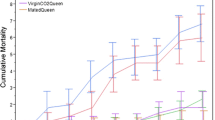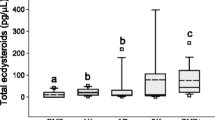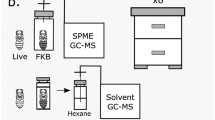Abstract
The influence of pheromones on insect physiology and behavior has been thoroughly reported for numerous aspects, such as attraction, gland development, aggregation, mate and kin recognition. Brood pheromone (BP) is released by honey bee larvae to indicate their protein requirements to the colony. Although BP is known to modulate pollen and protein consumption, which in turn can affect physiological and morphological parameters, such as hypopharyngeal gland (HPG) development and ovarian activation, few studies have focused on the effect of BP on nutritional balance. In this study, we exposed newly emerged worker bees for 14 d and found that BP exposure increased protein intake during the first few days, with a peak in consumption at day four following exposure. BP exposure decreased survival of caged honey bees, but did not affect either the size of the HPG acini or ovarian activation stage. The uncoupling of the BP releaser effect, facilitated by working under controlled conditions, and the presence of larvae as stimulating cues are discussed.



Similar content being viewed by others
References
Altaye SZ, Pirk CWW, Crewe RM, Nicolson SW (2010) Convergence of carbohydrate-biased intake targets in caged worker honeybees fed different protein sources. J Exp Biol 213:3311–3318
Archer CR, Pirk CWW, Wright GA, Nicolson SW (2014) Nutrition affects survival in African honeybees exposed to interacting stressors. Funct Ecol 28:913–923
Brand JM, Young JC, Silverstein RM (1979) Insect pheromones: a critical review of recent advances in their chemistry, biology, and application. In: Albersheim P, Brand JM, Darvill AG et al (eds) Fortschritte der Chemie organischer Naturstoffe/progress in the chemistry of organic natural products. Springer Vienna, Vienna, pp 1–190
Brodschneider R, Crailsheim K (2010) Nutrition and health in honey bees. Apidologie 41:278–294
Crailsheim K (1990) The protein balance of the honey bee worker. Apidologie 21:417–429
Crailsheim K, Schneider LHW, Hrassnigg N et al (1992) Pollen consumption and utilization in worker honeybees (Apis mellifera carnica): dependence on individual age and function. J Insect Physiol 38:409–419
Démares FJ, Crous KL, Pirk CWW et al (2016) Sucrose sensitivity of honey bees is differently affected by dietary protein and a neonicotinoid pesticide. PLoS One 11:e0156584
Du Plessis LM, De Villiers JBM, Van Der Walt WHJ (1985) Stability studies on methyl and ethyl fatty acid esters of sunflower seed oil. Am Oil Chem Soc 62:748
Dussutour A, Simpson SJ (2009) Communal nutrition in ants. Curr Biol 19:740–744
Dussutour A, Simpson SJ (2012) Ant workers die young and colonies collapse when fed a high-protein diet. P Roy Soc Lond B: Bio 279:2402–2408
Hagedorn HH, Moeller FE (1967) The rate of pollen consumption by newly emerged honeybees. J Apic Res 6:159–162
Haydak MH (1970) Honey bee nutrition. Annu Rev Entomol 15:143–156
Hoover SER, Higo HA, Winston ML (2006) Worker honey bee ovary development: seasonal variation and the influence of larval and adult nutrition. J Comp Physiol B 176:55–63
Howard RW, Blomquist GJ (2005) Ecological, behavioral, and biochemical aspects of insect hydrocarbons. Annu Rev Entomol 50:371–393
Hrassnigg N, Crailsheim K (1998) Adaptation of hypopharyngeal gland development to the brood status of honeybee (Apis mellifera L.) colonies. J Insect Physiol 44:929–939
Huang Z-Y, Otis GW (1989) Factors determining hypopharyngeal gland activity of worker honey bees (Apis mellifera L.) Insect Soc 36:264–276
Huang Z-Y, Otis GW, Teal PEA (1989) Nature of brood signal activating the protein synthesis of hypopharyngeal gland in honey bees, Apis mellifera (Apidae: hymenoptera). Apidologie 20:455–464
Human H, Nicolson SW, Strauss K et al (2007) Influence of pollen quality on ovarian development in honeybee workers (Apis mellifera scutellata). J Insect Physiol 53:649–655
Karlson P, Butenandt A (1959) Pheromones (ectohormones) in insects. Annu Rev Entomol 4:39–58
Köhler A, Pirk CWW, Nicolson SW (2012a) Honeybees and nectar nicotine: deterrence and reduced survival versus potential health benefits. J Insect Physiol 58:286–292
Köhler A, Pirk CWW, Nicolson SW (2012b) Simultaneous stressors: interactive effects of an immune challenge and dietary toxin can be detrimental to honeybees. J Insect Physiol 58:918–923
Köhler A, Nicolson SW, Pirk CWW (2013) A new design for honey bee hoarding cages for laboratory experiments. J Apic Res 52:12–14
Le Conte Y, Arnold G, Trouiller J et al (1990) Identification of a brood pheromone in honeybees. Naturwissenschaften 77:334–336
Le Conte Y, Sreng L, Poitout SH (1995) Brood pheromone can modulate the feeding behavior of Apis mellifera workers (Hytnenoptera: Apidae). J Econ Entomol 88:798
Le Conte Y, Mohammedi A, Robinson GE (2001) Primer effects of a brood pheromone on honeybee behavioural development. Proc Biol Sci 268:163
Leoncini I, Le Conte Y, Costagliola G et al (2004) Regulation of behavioral maturation by a primer pheromone produced by adult worker honey bees. Proc Natl Acad Sci U S A 101:17559–17564
Metz BN, Pankiw T, Tichy SE et al (2010) Variation in and responses to brood pheromone of the honey bee (Apis mellifera L.) J Chem Ecol 36:432–440
Michelette EF, Soares A (1993) Characterization of preimaginal developmental stages in Africanized honey bee workers (Apis mellifera L). Apidologie 24:431–431
Mohammedi A, Crauser D, Paris A, Le Conte Y (1996) Effect of a brood pheromone on honeybee hypopharyngeal glands. C R Acad Sci III Sci Vie 319:769–772
Münch D, Kreibich CD, Amdam GV (2013) Aging and its modulation in a long-lived worker caste of the honey bee. J Exp Biol 216:1638
Okosun OO, Yusuf AA, Crewe RM, Pirk CW (2015) Effects of age and reproductive status on tergal gland secretions in queenless honeybee workers Apis mellifera scutellata and A. M. capensis. J Chem Ecol 41:896–903
Pankiw T (2004) Cued in: honey bee pheromones as information flow and collective decision-making. Apidologie 35:217–226
Pankiw T (2007) Brood pheromone modulation of pollen forager turnaround time in the honey bee (Apis mellifera L.) J Insect Behav 20:173–180
Pankiw T, Page ER Jr, Kim Fondrk M (1998) Brood pheromone stimulates pollen foraging in honey bees (Apis mellifera). Behav Ecol Sociobiol 44:193–198
Pankiw T, Page RE (2003) Effect of pheromones, hormones, and handling on sucrose response thresholds of honey bees (Apis mellifera L.). J Comp Physiol A Neuroethol Sens Neural Behav Physiol 189(9):675–684
Pankiw T, Sagili RR, Metz BN (2008) Brood pheromone effects on colony protein supplement consumption and growth in the honey bee (hymenoptera: Apidae) in a subtropical winter climate. J Econ Entomol 101:1749
Pankiw T, Lafontaine JP, Avelino N (2010) Stabilized brood pheromone for manipulating the behavior and physiology of honey bees United States Patent No: 7727517
Pernal SF, Currie RW (2000) Pollen quality of fresh and 1-year-old single pollen diets for worker honey bees (Apis mellifera L.) Apidologie 31:387–409
Peters L, Zhu-Salzman K, Pankiw T (2010) Effect of primer pheromones and pollen diet on the food producing glands of worker honey bees (Apis mellifera L.) J Insect Physiol 56:132–137
Pirk CWW, Boodhoo C, Human H, Nicolson SW (2010) The importance of protein type and protein to carbohydrate ratio for survival and ovarian activation of caged honeybees (Apis mellifera scutellata). Apidologie 41:62–72
Rembold H, Kremer J-P, Ulrich GM (1980) Characterization of postembryonic developmental stages of the female castes of the honey bee, Apis mellifera L. Apidologie 11:29–38
Simpson SJ, Raubenheimer D (2012) The nature of nutrition: a unifying framework from animal adaptation to human obesity. Princeton University Press, Princeton
Slessor KN, Winston ML, Le Conte Y (2005) Pheromone communication in the honeybee (Apis mellifera L.) J Chem Ecol 31:2731–2745
Smedal B, Brynem M, Kreibich CD, Amdam GV (2009) Brood pheromone suppresses physiology of extreme longevity in honeybees (Apis mellifera). J Exp Biol 212:3795
Standifer LN (1967) A comparison of the protein quality of pollens for growth-stimulation of the hypopharyngeal glands and longevity of honey bees, Apis mellifera L. (hymenoptera: Apidae). Insect Soc 14:415–425
Wilson EO, Bossert WH (1963) Chemical communication among animals. Recent Prog Horm Res 19:673–716
Winston ML (1991) The biology of the honey bee. Harvard University Press, Cambridge
Yew JY, Chung H (2015) Insect pheromones: an overview of function, form, and discovery. Prog Lipid Res 59:88–105
Acknowledgements
FJD is supported by a postdoctoral fellowship from the University of Pretoria. The authors would like to thank Kendall Crous for beekeeping, Susana da Silva das Neves and Zoe van Vuuren for helping with dissections, and Alan Hall and the Laboratory for Microscopy and Microanalysis at the University of Pretoria for the HPG pictures.
Author information
Authors and Affiliations
Corresponding author
Ethics declarations
Conflict of Interest
The authors declare that they have no conflict of interest.
Electronic supplementary material
ESM 1
(PDF 695 kb)
Rights and permissions
About this article
Cite this article
Démares, F.J., Yusuf, A.A., Nicolson, S.W. et al. Effect of Brood Pheromone on Survival and Nutrient Intake of African Honey Bees (Apis mellifera scutellata) under Controlled Conditions. J Chem Ecol 43, 443–450 (2017). https://doi.org/10.1007/s10886-017-0840-1
Received:
Revised:
Accepted:
Published:
Issue Date:
DOI: https://doi.org/10.1007/s10886-017-0840-1




